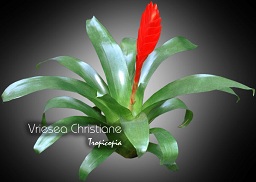Table of contents
Vriesea ‘Christiane’

Latin Name: Vriesea ‘Christiane’
Category: Bromeliad
Family: Bromeliaceae
Origin: Cultivar
Climate: Tropical
Growing Zones: 11-10
Care Instructions
The Vriesea ‘Christiane’ (Vriesea ‘Christiane’) is a tropical plant that originates from Cultivar. This bromeliad plant belongs to the Bromeliaceae family and is well-suited for growing in USDA zones 11-10.
Complete Care Guide for Vriesea ‘Christiane’
Watering Requirements
Vriesea ‘Christiane’ is a bromeliad that thrives in a humid environment, making its watering requirements unique compared to many other houseplants. It is essential to keep the central rosette filled with water, as this is where the plant absorbs moisture. Water the plant thoroughly, allowing excess water to drain out of the pot. During the growing season (spring and summer), you should water the plant every 1-2 weeks, ensuring that the soil remains slightly moist but not soggy. In the fall and winter, reduce watering frequency to once every 2-3 weeks, as the plant enters a dormant phase. Always use room temperature water to avoid shocking the plant, and consider misting the leaves regularly to maintain humidity levels.
Light Conditions
Vriesea ‘Christiane’ prefers bright, indirect light to thrive. Direct sunlight can scorch its leaves, leading to brown tips and overall decline in health. Ideally, place your Vriesea near a window that receives filtered light, such as through sheer curtains. If you notice the plant stretching towards the light or the colors fading, it may be a sign that it needs more light. Conversely, if the leaves are turning yellow or brown, it may be receiving too much direct sunlight. A well-lit room with dappled sunlight is perfect for this beautiful bromeliad.
Soil Preferences
Vriesea ‘Christiane’ thrives in well-draining soil that retains some moisture without becoming waterlogged. A mix designed for orchids or a specialized bromeliad potting mix is ideal, as it typically contains components like pine bark, perlite, and sphagnum moss, which provide excellent drainage and aeration. If you prefer to create your own mix, combine equal parts of peat moss, perlite, and orchid bark. Fertilization should be done sparingly; use a balanced, water-soluble fertilizer diluted to half strength every 4-6 weeks during the growing season. Avoid fertilizing during the dormant winter months to prevent root burn.
Pests and Diseases
While Vriesea ‘Christiane’ is relatively pest-resistant, it can still be susceptible to common pests such as mealybugs, aphids, and spider mites. Regularly inspect the undersides of leaves and the central rosette for any signs of infestation. If you notice pests, treat them promptly with insecticidal soap or neem oil, ensuring to cover all affected areas. Additionally, Vriesea can suffer from root rot if overwatered or if the soil does not drain well. To prevent this, ensure that the pot has adequate drainage holes and that you allow the soil to dry slightly between waterings. Fungal infections can also occur, particularly in overly humid conditions, so maintaining good air circulation around the plant is crucial.
Special Care Tips
To keep your Vriesea ‘Christiane’ healthy and vibrant, consider the following special care tips: First, maintain a consistent humidity level of around 50-70% for optimal growth. If your home is dry, especially during winter, using a humidity tray or a room humidifier can help. Additionally, avoid placing the plant near heating vents or air conditioning units, as these can create temperature fluctuations that stress the plant. Regularly clean the leaves with a damp cloth to remove dust and allow the plant to photosynthesize effectively. Lastly, consider repotting your Vriesea every 2-3 years to refresh the soil and provide more space for growth, using a pot that is only slightly larger than the current one to prevent overwatering issues.








